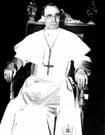
|
|
|

|

|

|

|
|
Click on an image to see a larger, more detailed picture.
|
|
|
|
|
| 1942: The "Final Solution" |

|
pg. 403 |

|
|
|
|
| |
 The December 28, 1942, entry in the Chronicle of the Lódz Ghetto tersely reports: "Cold again." Here, young children and elderly Jews from the ghetto forage for bits of coal. For the inhabitants of the Lódz (Poland) Ghetto, the fierce and unrelenting chill caused even more deaths than did hunger. Within the ghetto, hopeful rumors of bread and sausage--even eggs--in honor of the Christmas holidays circulated among the populace, only to be proved untrue.
The December 28, 1942, entry in the Chronicle of the Lódz Ghetto tersely reports: "Cold again." Here, young children and elderly Jews from the ghetto forage for bits of coal. For the inhabitants of the Lódz (Poland) Ghetto, the fierce and unrelenting chill caused even more deaths than did hunger. Within the ghetto, hopeful rumors of bread and sausage--even eggs--in honor of the Christmas holidays circulated among the populace, only to be proved untrue.
Photo: YIVO / United States Holocaust Memorial Museum Photo Archive
|
 Abraham Stern, a Polish Jew who left to study at the Hebrew University in Palestine, founded the Fighters for the Freedom of Israel (FFI), a guerrilla organization designed both to promote Jewish emigration to Palestine and secure Israel's independence. Known to the British as the "Stern Gang," the FFI was widely regarded in Britain as one of the most active and extreme groups working for the establishment of a Jewish state.
Abraham Stern, a Polish Jew who left to study at the Hebrew University in Palestine, founded the Fighters for the Freedom of Israel (FFI), a guerrilla organization designed both to promote Jewish emigration to Palestine and secure Israel's independence. Known to the British as the "Stern Gang," the FFI was widely regarded in Britain as one of the most active and extreme groups working for the establishment of a Jewish state.
Photo: Bildarchiv Preussischer Kulturbesitz
|
 The Vatican
The Vatican
Events in 1942 illustrate why the Holocaust provokes controversy about the Vatican and the Roman Catholic Church. The church's European network--bishops, diplomats, couriers, priests, and their parishioners--kept the Vatican and Pope Pius XII (pictured) informed about the fate of Europe's Jews. Nevertheless, responding to reports about deportations and mass killings that occured in 1941 and 1942, Vatican Secretary of State Cardinal Luigi Maglione regarded the news as unverified if not exaggerated. Anxious for papal condemnation of Nazi Germany's treatment of the Jews, the Allies urged Pius XII to support a December 17, 1942, declaration entitled "German Policy of Extermination of the Jewish Race." The Vatican had protested atrocities in general, Cardinal Maglione replied. He went on to explain, however, that the Pope could not publicly condemn particular atrocities. On December 24 Pius XII, in a veiled reference to Jews, lamented the "hundreds of thousands who through no fault of their own, and sometimes only because of their nation or race, have been consigned to death or slow decline." Disputes about what the Vatican could or should have done during the Holocaust will be clarified but not resolved when its wartime archives are fully opened.
|
|

|

|

|

|
 December 26, 1942: Twenty-year-old French royalist Fernand Bonnier de la Chapelle is executed by Vichy firing squad two days after fatally wounding Vichy Admiral Francois Jean Darlan.
December 26, 1942: Twenty-year-old French royalist Fernand Bonnier de la Chapelle is executed by Vichy firing squad two days after fatally wounding Vichy Admiral Francois Jean Darlan.
|
 December 28, 1942: Two Jews are shot for mutiny at the Stalowa Wola, Poland, slave-labor camp.
December 28, 1942: Two Jews are shot for mutiny at the Stalowa Wola, Poland, slave-labor camp.
|
 December 28, 1942: Dr. Carl Clauberg begins his sterilization experiments on women prisoners at Auschwitz.
December 28, 1942: Dr. Carl Clauberg begins his sterilization experiments on women prisoners at Auschwitz.
|
 December 30, 1942: Pope Pius XII tells an American representative that he regards the atrocity stories about Jews as exaggerations "for the purposes of propaganda."
December 30, 1942: Pope Pius XII tells an American representative that he regards the atrocity stories about Jews as exaggerations "for the purposes of propaganda."
|
 December 31, 1942: By this date, the German Reich has deported more than two million Jews to death camps. Hundreds of thousands more Jews have been murdered by Einsatzgruppen and police battalions.
December 31, 1942: By this date, the German Reich has deported more than two million Jews to death camps. Hundreds of thousands more Jews have been murdered by Einsatzgruppen and police battalions.
|
|
|
|
|
| 1942: The "Final Solution" |

|
pg. 403 |

|
|
The Holocaust Chronicle
© 2009 Publications International, Ltd.
|
|
